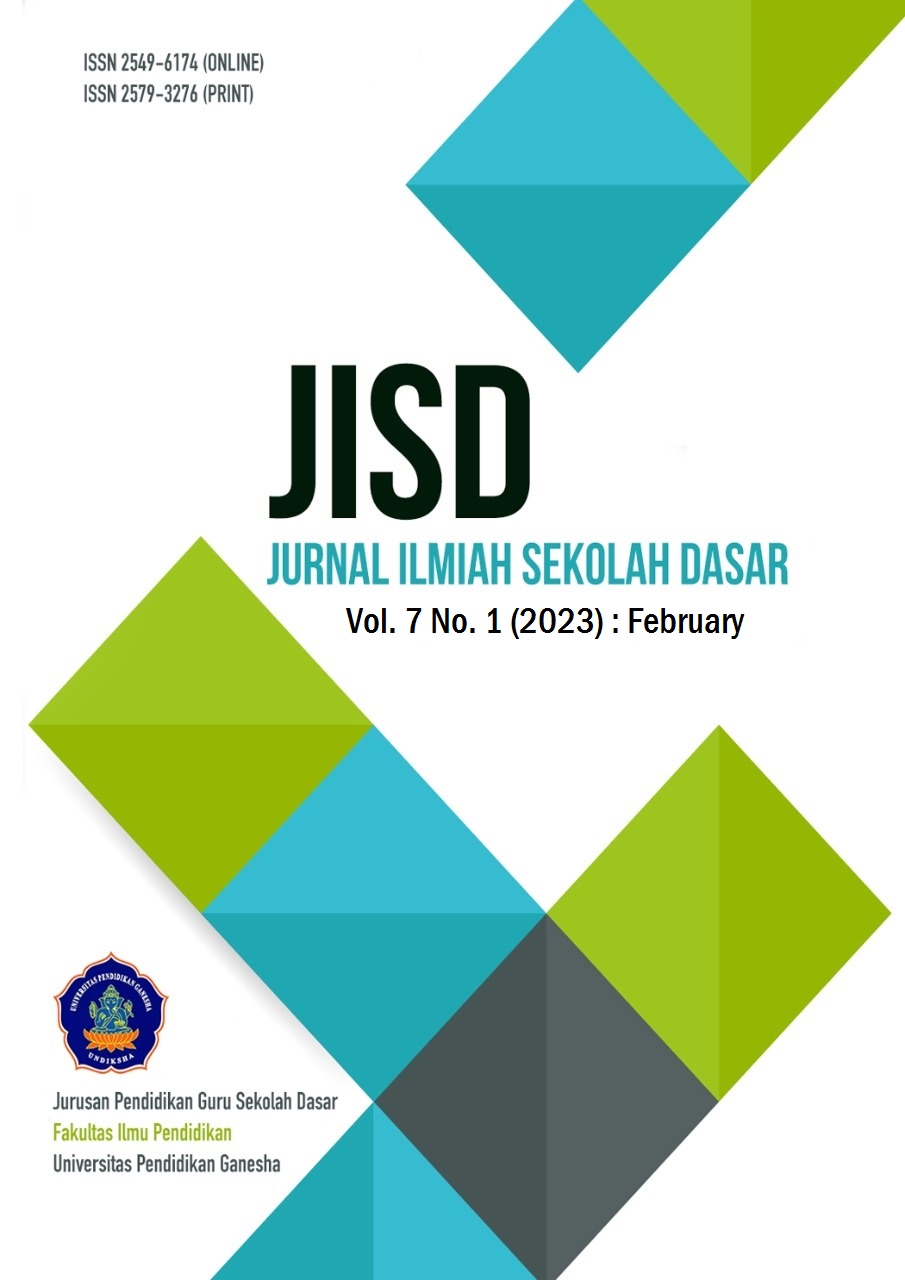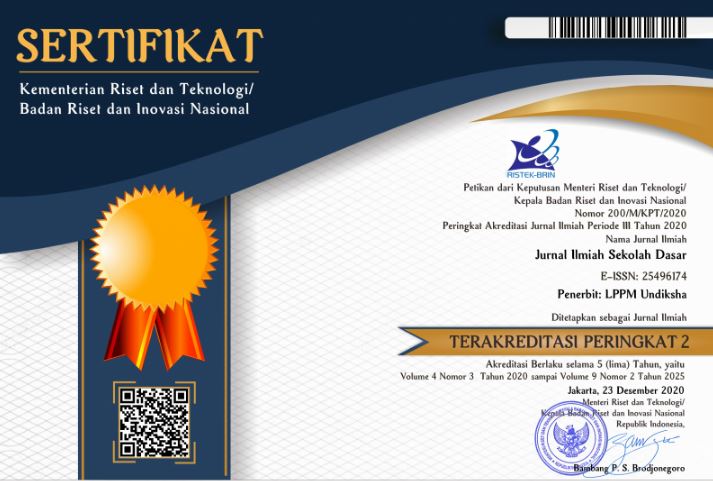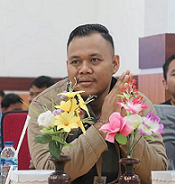Digital Picture Storybooks, Can Increase Students' Self-Efficacy and Interest in Learning?
DOI:
https://doi.org/10.23887/jisd.v7i1.54457Kata Kunci:
Digital picture storybooks, self-efficacy, learning interestAbstrak
There are still many students who need help with self-efficacy. This problem has an impact on the low interest in learning. One way to overcome these problems is to use appropriate learning media. This study aims to produce digital picture storybooks reviewed from the feasibility aspect based on the results of validation by experts and to know the practicality and effectiveness of digital picture storybooks in increasing self-efficacy and learning interest in fourth-grade elementary school students. This research is research and development with the Borg & Gall model. Data collection was carried out through interviews, scales, and questionnaires. Data analysis used the N Gain test, Independent Sample t-Test, Paired Sample t Test, and the MANOVA test. The results showed that digital picture storybooks were feasible to use based on the results of the validation of material experts and the results of validation of media experts and practical use based on the results of the teacher's response questionnaire and the results of student responses. The results of the N Gain test showed an increase in self-efficacy and student learning interest in the experimental group, which was higher than the control class. It was concluded that digital picture storybooks effectively increased the self-efficacy and learning interest of fourth-grade elementary school students.
Referensi
Adriana, O. :, Ditjen, D., Katolik, B., & Agama, K. (2020). Efektivitas Pembelajaran Daring Di Masa Pandemi Covid-19 Pada Perguruan Tinggi Keagamaan Katolik. Edutech, 19(3), 241–262. https://doi.org/10.33319/sos.v21i2.61. DOI: https://doi.org/10.31605/ijes.v3i1.788
Aka, K. A. (2019). Integration Borg & Gall (1983) and Lee & Owen (2004) models as an alternative model of design-based research of interactive multimedia in elementary school. Journal of Physics: Conference Series, 1318(1). https://doi.org/10.1088/1742-6596/1318/1/012022. DOI: https://doi.org/10.1088/1742-6596/1318/1/012022
Anggraini, I. A., Utami, W. D., & Rahma, S. B. (2020). Mengidentifikasi Minat Bakat Siswa Sejak Usia Dini di SD Adiwiyata. ISLAMIKA, 2(1), 161–169. https://doi.org/https://doi.org/10.36088/islamika.v2i1.570. DOI: https://doi.org/10.36088/islamika.v2i1.570
Annisa, M. N., Wiliah, A., & Rahmawati, N. (2020). Pentingnya pendidikan karakter pada anak sekolah dasar di zaman serba digital. BINTANG, 2(1), 35–48. https://doi.org/10.36088/bintang.v2i1.558.
Ardhiniswari, Subroto, & Jacky. (2020). Pengembangan Media Digital Picture Book Berbasis. Jurnal Education and Development, 8(3), 363–371. http://journal.ipts.ac.id/index.php/ED/article/view/2001.
Artino, A. R. (2012). Academic self efficacy: from educational theory to instructional process. Perspective on Medical Education, 1(2), 76–85. https://doi.org/http://dx.doi.org/10.1007/s40037-012-0012-5. DOI: https://doi.org/10.1007/S40037-012-0012-5
Avelar, D., Dore, R. A., Schwichtenberg, A. J., Roben, C. K. P., Hirsh-Pasek, K., & Golinkoff, R. M. (2022). Children and parents’ physiological arousal and emotions during shared and independent e-book reading: A preliminary study. International Journal of Child-Computer Interaction, 33, 100507. https://doi.org/https://doi.org/10.1016/j.ijcci.2022.100507. DOI: https://doi.org/10.1016/j.ijcci.2022.100507
Bai, J., Zhang, H., Chen, Q., Cheng, X., & Zhou, Y. (2022). Technical Supports and Emotional Design in Digital Picture Books for Children: A Review. Procedia Computer Science, 201, 174–180. https://doi.org/https://doi.org/10.1016/j.procs.2022.03.025. DOI: https://doi.org/10.1016/j.procs.2022.03.025
Bus, A. G., & Anstadt, R. (2021). Toward Digital Picture Books for a New Generation of Emergent Readers. 7(1), 1–15. https://doi.org/10.1177/23328584211063874. DOI: https://doi.org/10.1177/23328584211063874
Carvalho, J. L., González, R. L., Casas García, L. M., & Juarez, J. C. (2019). What Is Better to Study: The Printed Book or the Digital Book?: An Exploratory Study of Qualitative Nature. Advances in Intelligent Systems and Computing, 861, 34–45. https://doi.org/10.1007/978-3-030-01406-3_4. DOI: https://doi.org/10.1007/978-3-030-01406-3_4
Chen, S.-Y. (2022). To explore the impact of augmented reality digital picture books in environmental education courses on environmental attitudes and environmental behaviors of children from different cultures. In Frontiers in Psychology (Vol. 13). https://doi.org/10.3389/fpsyg.2022.1063659. DOI: https://doi.org/10.3389/fpsyg.2022.1063659
Cheung, D. (2018). The Key Factors Affecting Students’ Individual Interest in School Science Lessons. International Journal of Science Education, 40(1), 1–23. https://doi.org/https://doi.org/10.1080/09500693.2017.1362711. DOI: https://doi.org/10.1080/09500693.2017.1362711
Ciampa, K. (2016). Motivating Grade 1 Children to Read : Exploring the Role of Choice , Curiosity , and Challenge in Mobile Ebooks. Reading Psychology, 37(5), 665–705. https://doi.org/10.1080/02702711.2015.1105337. DOI: https://doi.org/10.1080/02702711.2015.1105337
Colwell, C. (2013). Children’s storybooks in the elementary music classroom : A description of their use by orff-schulwerk teachers. Music Therapy & Special Music Education, 5(2), 175–187. https://kuscholarworks.ku.edu/handle/1808/14153.
Damayanti, N. P. S., Jayanta, I. N. L., & Yudiana, K. (2021). Pop-Up Book Media on the Topic of Plants’ Anatomy and Physiology. Jurnal Ilmiah Sekolah Dasar, 5(3), 505. https://doi.org/10.23887/jisd.v5i3.37191. DOI: https://doi.org/10.23887/jisd.v5i3.37191
Danaei, D., Jamali, H. R., Mansourian, Y., & Rastegarpour, H. (2020). Comparing reading comprehension between children reading augmented reality and print storybooks. Computers and Education, 153, 103900. https://doi.org/10.1016/j.compedu.2020.103900. DOI: https://doi.org/10.1016/j.compedu.2020.103900
Divayana, D. G. H., Suyasa, P. W. A., & Widiartini, N. K. (2021). An innovative model as evaluation model for information technology-based learning at ICT vocational schools. Heliyon, 7(2), e06347. https://doi.org/10.1016/j.heliyon.2021.e06347. DOI: https://doi.org/10.1016/j.heliyon.2021.e06347
Eng, C. M., Tomasic, A. S., & Thiessen, E. D. (2020). Contingent responsivity in ebooks modeled from quality adult-child interactions: Effects on children’s learning and attention. Developmental Psychology, 56(2), 285–297. https://doi.org/https://doi.org/10.1037/dev0000869. DOI: https://doi.org/10.1037/dev0000869
Ghufron, M. N., & Risnawita, R. (2016). Teori-Teori Psikologi. Ar-Ruzz Media.
Güler ARI, T. (2017). Study into the Views of Classroom Teachers Upon Interest-Based Learning in Prımary Schools. Uluslararası Türkçe Edebiyat Kültür Eğitim Dergisi, 6(4), 2776–2787. https://dergipark.org.tr/en/pub/teke/issue/34165/384016. DOI: https://doi.org/10.7884/teke.4053
Halim, D., & Munthe, A. P. (2019). Dampak Pengembangan Buku Cerita Bergambar Untuk Anak Usia Dini. Scholaria: Jurnal Pendidikan Dan Kebudayaan, 9(3), 203–216. https://doi.org/10.24246/j.js.2019.v9.i3.p203-216. DOI: https://doi.org/10.24246/j.js.2019.v9.i3.p203-216
Hamimah, Chandra, Anita, Y., & Kharisma, A. (2022). Feasibility of the Ethno Social Learning Model for Elementary Children. 6(3), 550–557. https://doi.org/https://doi.org/10.23887/jisd.v6i3.51304. DOI: https://doi.org/10.23887/jisd.v6i3.51304
Handayani, S. L. (2022). ANIMA-LIE: Android-Based Learning Media on Animal Life Cycles Materials for Elementary School. Jurnal Ilmiah Sekolah Dasar, 6(2), 287–294. https://doi.org/10.23887/jisd.v6i2.45359. DOI: https://doi.org/10.23887/jisd.v6i2.45359
Herlina, V., Yarmi, G., & Yuliati, S. R. (2019). Pengembangan Buku Cerita Anak Digital Berbasis Literasi Digital pada Siswa Kelas V Sekolah Dasar. Dinamika Sekolah Dasar, 1–13. https://doi.org/https://doi.org/10.21009/DSD.XXX.
Islami, N. D. (2019). Pengembangan Bahan Ajar Buku Cerita Bergambar Tema 5 “ Pengalamanku” Untuk Meningkatkan Minat & Hasil Belajar Siswa Kelas 1 Madrasah Ibtidaiyah (MI) Mambaul Ulum Sepanjang Gondanglegi Malang. UIN Maulana Malik Ibrahim. DOI: https://doi.org/10.31602/muallimuna.v5i2.2879
Isnani, G. (2017). The Influence of Classroom Climate, Learning Interest, Learning Discipline and Learning Motivation to Learning Outcomes on Productive Subjects. JPBM (Jurnal Pendidikan Bisnis Dan Manajemen), 3(2), 85–96. https://doi.org/http://dx.doi.org/10.17977/um003v3i22017p085. DOI: https://doi.org/10.17977/um003v3i22017p085
Laine, E., Veermans, M., Lahti, A., & Veermans, K. (2017). Generation of Student Interest in an Inquiry_Based Mobile Learning Environment. Frontline Learning Research, 5(4), 42–60. https://doi.org/https://doi.org/10.14786/flr.v5i4.306. DOI: https://doi.org/10.14786/flr.v5i4.306
Lindgren, & Bleicher. (2005). Success In Learning And Preservice Science Teaching Self Efficacy. Journal of Science Teacher Education, 16, 205–225. https://doi.org/10.1007/s10972-005-4861-1. DOI: https://doi.org/10.1007/s10972-005-4861-1
Lubis, A. H., & Dasopang, M. D. (2020). Pengembangan Buku Cerita Bergambar Berbasis Augmented Reality untuk Mengakomodasi Generasi Z. 2017, 780–791. https://doi.org/http://dx.doi.org/10.17977/jptpp.v5i6.13613. DOI: https://doi.org/10.17977/jptpp.v5i6.13613
Lukman, A., Hayati, D. K., & Hakim, N. (2019). Pengembangan Video Animasi Berbasis Kearifan Lokal pada Pembelajaran IPA Kelas V di Sekolah Dasar. Elementary: Jurnal Ilmiah Pendidikan Dasar, 5(2), 153. https://doi.org/10.32332/elementary.v5i2.1750. DOI: https://doi.org/10.32332/elementary.v5i2.1750
Mohd Rosmadi, I., & Mohamed Isa, Z. (2019). Essential Elements of Children’S Story Books in Islamic Pedagogy Based on Al-Quran To Cultivate Prosocial Behaviour Among Preschool Children. International Journal of Education, Psychology and Counseling, 29, 204–214. https://doi.org/10.35631/ijepc.4310017. DOI: https://doi.org/10.35631/IJEPC.4310017
Montag, J. L. (2019). Differences in sentence complexity in the text of children ’ s picture books and child-directed speech. First Language, 39(5), 527–546. https://doi.org/10.1177/0142723719849996. DOI: https://doi.org/10.1177/0142723719849996
Nengrum, T. A., Pettasolong, N., & Nuriman, M. (2021). Kelebihan dan Kekurangan Pembelajaran Luring dan Daring dalam Pencapaian Kompetensi Dasar Kurikulum Bahasa Arab di Madrasah Ibtidaiyah 2 Kabupaten Gorontalo. Jurnal Pendidikan, 30(1), 1. https://doi.org/10.32585/jp.v30i1.1190. DOI: https://doi.org/10.32585/jp.v30i1.1190
Ngatiman, N., & Ibrahim, R. (2018). Pendidikan Karakter Dalam Perspektif Pendidikan Islam. Manarul Qur’an: Jurnal Ilmiah Studi Islam, 18(2). https://doi.org/10.32699/mq.v18i2.949. DOI: https://doi.org/10.32699/mq.v18i2.949
Nuswantari, N. (2018). Model pembelajaran nilai-nilai toleransi untuk anak sekolah dasar. Premiere Educandum : Jurnal Pendidikan Dasar Dan Pembelajaran, 8(1). https://doi.org/10.25273/pe.v8i1.2255. DOI: https://doi.org/10.25273/pe.v8i1.2255
Permatasari, B. D., Gunarhadi, & Riyadi. (2019). The influence of problem based learning towards social science learning outcomes viewed from learning interest. International Journal of Evaluation and Research in Education, 8(1), 39–46. https://doi.org/10.11591/ijere.v8i1.15594. DOI: https://doi.org/10.11591/ijere.v8i1.15594
Phoon, H.-Y., Roslan, R., Shahrill, M., & Said, H. M. (2020). The Role of Comics in Elementary School Science Education. Formatif: Jurnal Ilmiah Pendidikan MIPA, 10(2), 67–76. https://doi.org/10.30998/formatif.v10i2.6257. DOI: https://doi.org/10.30998/formatif.v10i2.6257
Purwanti, D. (2017). Pendidikan Karakter Peduli Lingkungan Dan Implementasinya. Dwija Cendekia: Jurnal Riset Pedagogik, 1(2). https://doi.org/10.20961/jdc.v1i2.17622. DOI: https://doi.org/10.20961/jdc.v1i2.17622
Putrislia, N. A., & Airlanda, G. S. (2021). Jurnal basicedPengembangan e-book cerita bergambar proses terjadinya hujan untuk meningkatkan minat membaca siswa di sekolah dasar. Jurnal Basicedu, 5(3), 1683–1688. https://doi.org/10.31004/basicedu.v5i4.1032. DOI: https://doi.org/10.31004/basicedu.v5i4.1032
Rahim, R., Suhariyanti, S., & Rahman, M. A. (2022). The development of comic-based teaching material using contextual approach to students of amalyatul huda elementary school medan. Premiere Educandum : Jurnal Pendidikan Dasar Dan Pembelajaran, 12(1), 1. https://doi.org/10.25273/pe.v12i1.10416. DOI: https://doi.org/10.25273/pe.v12i1.10416
Rahimah, F. Y., & Izzaty, R. E. (2018). Developing Picture Story Book Media for Building the Self-Awareness of Early Childhood Children. Jurnal Obsesi : Jurnal Pendidikan Anak Usia Dini, 2(2), 219. https://doi.org/10.31004/obsesi.v2i2.102. DOI: https://doi.org/10.31004/obsesi.v2i2.102
Ratnasari, E. M., & Zubaidah, E. (2019). Pengaruh Penggunaan Buku Cerita Bergambar Terhadap Kemampuan Berbicara Anak. Scholaria: Jurnal Pendidikan Dan Kebudayaan, 9(3), 267–275. https://doi.org/10.24246/j.js.2019.v9.i3.p267-275. DOI: https://doi.org/10.24246/j.js.2019.v9.i3.p267-275
Retnowati, G., Salim, R. M. A., & Saleh, A. Y. (2018). Effectiveness of Picture Story Books Reading to Increase Kindness in Children Aged 5-6 Years. Lingua Cultura, 12(1), 89. https://doi.org/10.21512/lc.v12i1.2095. DOI: https://doi.org/10.21512/lc.v12i1.2095
Rina, N., Suminar, J. R., Damayani, N. A., & Hafiar, H. (2020). Character education based on digital comic media. International Journal of Interactive Mobile Technologies, 14(3), 107–127. https://doi.org/10.3991/ijim.v14i03.12111. DOI: https://doi.org/10.3991/ijim.v14i03.12111
Rohma, S. (2021). Development of Picture Stories Electronic Book (E-Book) for German Learning at Class X Madrasah Aliyah Negeri 1 Malang City. Journal Deutsch Als Fremdsprache in Indonesien, 5(1), 36–43. https://doi.org/http://dx.doi.org/10.17977/um079v5i12021p36-43. DOI: https://doi.org/10.17977/um079v5i12021p36-43
Safitri Anisa, & Dewi Rahmani. (2021). Pengembangan Bahan Ajar Berbasis Kontekstual Materi Aritmetika Sosial untuk Meningkatkan Kemampuan Berpikir Kritis Matematis pada Pembelajaran Preprospec Berbantuan TIK. PRISMA, Prosiding Seminar Nasional Matematika, 4, 59–66.
Selasih, N. N. (2017). Upaya Guru Dalam Meningkatkan Kreativitas Peserta Didik Di Era Globalisasi. Guna Widya: Jurnal Pendidikan Hindu, 4(2), 13–22. https://doi.org/10.25078/gw.v4i2.1054. DOI: https://doi.org/10.25078/gw.v4i2.1054
Sert, N., & Boynueğri, E. (2017). Digital technology use by the students and english teachers and self-directed language learning. World Journal on Educational Technology: Current Issues, 9(1), 24–34. https://doi.org/10.18844/wjet.v9i1.993. DOI: https://doi.org/10.18844/wjet.v9i1.993
Setiawan, J., Aman, & Wulandari, T. (2020). Understanding Indonesian history, interest in learning history and national insight with nationalism attitude. International Journal of Evaluation and Research in Education, 9(2), 364–373. https://doi.org/10.11591/ijere.v9i2.20474. DOI: https://doi.org/10.11591/ijere.v9i2.20474
Sipahutar, I. E. (2020). Edukasi dengan Media Komik terhadap Efikasi Diri Upaya Pencegahan Kekerasan Seksual pada Anak Usia Sekolah. Jurnal Gema Keperawatan, 13(2), 59–68. https://doi.org/10.33992/jgk.v13i2.1318. DOI: https://doi.org/10.33992/jgk.v13i2.1318
Siregar, N. (2019). Hubungan Self-Efficacy Dengan Hasil Belajar Matematika Siswa Kelas Rendah. Journal Of Mathematics Science And Education, 1(2), 64–72. https://doi.org/10.31540/jmse.v1i2.459. DOI: https://doi.org/10.31540/jmse.v1i2.459
Sökmen, Y. (2021). The role of self-efficacy in the relationship between the learning environment and student engagement. Educational Studies, 47(1), 19–37. https://doi.org/10.1080/03055698.2019.1665986. DOI: https://doi.org/10.1080/03055698.2019.1665986
Son, S. C., Butcher, K. R., & Liang, L. A. (2020). The Influence of Interactive Features in Storybook Apps on Children’s Reading Comprehension and Story Enjoyment. The Elementary School Journal, 120(3), 422–454. https://doi.org/https://doi.org/10.1086/707009. DOI: https://doi.org/10.1086/707009
Sumaryanti, L. (2020). Menumbuhkan minat baca anak MI/SD dengan media buku bergambar seri. AL-ASASIYYA: Journal Of Basic Education, 4(2), 173. https://doi.org/10.24269/ajbe.v4i2.2699. DOI: https://doi.org/10.24269/ajbe.v4i2.2699
Suriadi, H. J., Firman, F., & Ahmad, R. (2021). Analisis Problema Pembelajaran Daring Terhadap Pendidikan Karakter Peserta Didik. Edukatif : Jurnal Ilmu Pendidikan, 3(1). https://doi.org/10.31004/edukatif.v3i1.251. DOI: https://doi.org/10.31004/edukatif.v3i1.251
Susanto, A. (2016). Teori Belajar dan Pembelajaran di SD. Prenadamedia Group.
Tafonao, T. (2018). Peranan Media Pembelajaran Dalam Meningkatkan Minat Belajar Mahasiswa. Jurnal Komunikasi Pendidikan, 2(2), 103. https://doi.org/10.32585/jkp.v2i2.113. DOI: https://doi.org/10.32585/jkp.v2i2.113
Takacs, Z. K., & Bus, A. G. (2018). How pictures in picture storybooks support young children’s story comprehension: An eye-tracking experiment. Journal of Experimental Child Psychology, 174, 1–12. https://doi.org/10.1016/j.jecp.2018.04.013. DOI: https://doi.org/10.1016/j.jecp.2018.04.013
Tampubolon, J. (2020). Supervisi Korektif Untuk Menemukan Kekurangan –Kekurangan Guru Kelas dalam Malaksanakan Pembelajaran di SD Negeri 173105 Tarutung. Attractive : Innovative Education Journal, 2(2), 1–13. https://doi.org/http://dx.doi.org/10.51278/aj.v2i2.55. DOI: https://doi.org/10.51278/aj.v2i2.55
Toh, T. L., Cheng, L. P., Ho, S. Y., Jiang, H., & Lim, K. M. (2017). Use of comics to enhance students’ learning for the development of the twenty-first century competencies in the mathematics classroom. Asia Pacific Journal of Education, 37(4), 437–452. https://doi.org/10.1080/02188791.2017.1339344. DOI: https://doi.org/10.1080/02188791.2017.1339344
van Dinther, M., Dochy, F., Segers, M., & Braeken, J. (2014). Student perceptions of assessment and student self-efficacy in competence-based education. Educational Studies, 40(3), 330–351. https://doi.org/10.1080/03055698.2014.898577. DOI: https://doi.org/10.1080/03055698.2014.898577
Wajdi, M., Jamaluddin, A. Bin, Nurdiyanti, N., & Magfirah, N. (2022). The effectiveness of problem-based learning with environmental-based comic in enhancing students environmental literacy. International Journal of Evaluation and Research in Education, 11(3), 1049–1057. https://doi.org/10.11591/ijere.v11i3.22140. DOI: https://doi.org/10.11591/ijere.v11i3.22140
Weng, S.-S., & Chen, H.-C. (2020). Exploring the Role of Deep Learning Technology in the Sustainable Development of the Music Production Industry. Sustainability, 12(2), 625. https://doi.org/10.3390/su12020625. DOI: https://doi.org/10.3390/su12020625
Yang, P.-L. (2018). E-Books to Enhance College Learners’ English Self-Efficacy. Education Quarterly Reviews, 1(1), 66–82. https://doi.org/10.31014/aior.1993.01.01.7. DOI: https://doi.org/10.31014/aior.1993.01.01.7
Yilmaz, A. (2016). Devising A Structural Equation Model of Relationships between Preservice Teachers ’ Time and Study Environment Management, Effort Regulation, Self-efficacy, Control of Learning Beliefs, and Metacognitive Self-Regulation. Science Education International, 27(2), 301–316. https://eric.ed.gov/?id=EJ1104668.
Zuriah, N., Sunaryo, H., & Yusuf, N. (2016). IbM Guru Dalam Pengembangan Bahan Ajar Kreatif Inovatif Berbasis Potensi Lokal. Dedikasi, Vol. 13, 39. https://doi.org/https://doi.org/10.22219/dedikasi.v13i0.3136.
Zuya, Kwalat, & Attah. (2016). Pre service teachers’ mathematics self efficacy and mathematics teaching self efficacy. Journal of Education and Practice, 7(14), 93–98. https://eric.ed.gov/?id=EJ1102977.
Unduhan
Diterbitkan
Cara Mengutip
Terbitan
Bagian
Lisensi
Hak Cipta (c) 2022 Muhammad Nazimuddin Al Kamil

Artikel ini berlisensiCreative Commons Attribution-ShareAlike 4.0 International License.
Authors who publish with the Journal Ilmiah Sekolah Dasar agree to the following terms:
- Authors retain copyright and grant the journal the right of first publication with the work simultaneously licensed under a Creative Commons Attribution License (CC BY-SA 4.0) that allows others to share the work with an acknowledgment of the work's authorship and initial publication in this journal.
- Authors are able to enter into separate, additional contractual arrangements for the non-exclusive distribution of the journal's published version of the work (e.g., post it to an institutional repository or publish it in a book), with an acknowledgment of its initial publication in this journal.
- Authors are permitted and encouraged to post their work online (e.g., in institutional repositories or on their website) prior to and during the submission process, as it can lead to productive exchanges, as well as earlier and greater citation of published work. (See The Effect of Open Access)











